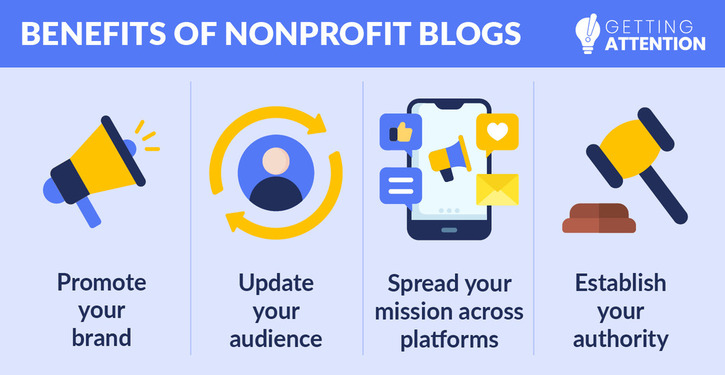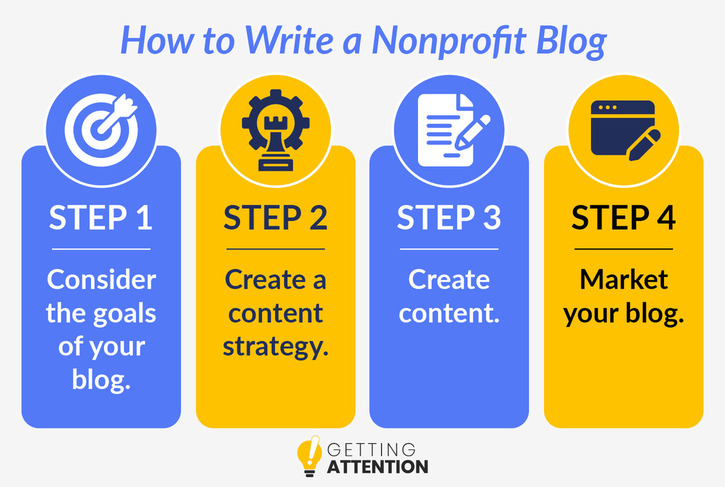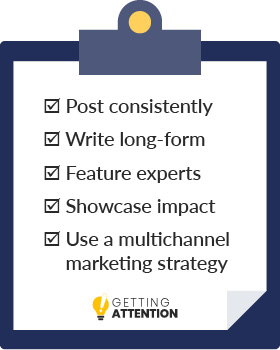Top Nonprofit Blogs & Tips: How to Master Content Marketing
Did you know 92% of nonprofit marketers use some form of content marketing? That’s because it works! Blogging is an easy, effective way to boost your online presence. Nonprofit blogs use a mix of storytelling techniques to attract donors, increase audience engagement, and establish authority.
At Getting Attention, we help nonprofits elevate their online marketing efforts through Google Ad Grant optimization. That said, through those efforts, we’ve seen firsthand what can make or break a nonprofit’s blog! In this comprehensive guide, we’ll cover the following information, including the importance of nonprofit blogs as well as best practices for curating content:
At the end of the guide, we’ll explore some note-worthy examples of blogs in the nonprofit space to kick off your brainstorming and make blogging a valuable part of your marketing plan. Let’s get started.

Overview of Nonprofit Blogs
Nonprofit blogs are dedicated resources hosted on the websites of charitable organizations, fundraising professionals and consultants, and nonprofit software companies. Blogs can range in style and content, from educational guides and industry updates to current events and impact stories. But each nonprofit blog shares a common goal: driving traffic to the organization’s website.
A nonprofit blog acts as a powerful search engine optimization (SEO) tool. While your main website provides the basic information for your mission and goals, your blog should explore topics that potential supporters might search for on Google. When your blog consistently posts valuable content that’s optimized for highly-searched keywords, it will become a go-to resource that ranks highly on search engine result pages and attracts new prospects.

If you find yourself asking, “Does my nonprofit need a blog?” the answer is likely yes! Blogging is an easy, effective way to stand out and engage with your audience. Since charitable organizations rely on raising awareness, blogs can help your organization to:
- Promote your brand. A nonprofit blog is essentially free advertising. Spread the word about your nonprofit’s impact through engaging content.
- Provide regular updates to your audience. Blogs allow nonprofits to easily publish content with updates about accomplishments, campaigns, and events.
- Share your content and mission across platforms. The more content you have on the web, the more likely it is that someone will come across your mission and take action.
- Establish your authority. Show potential donors that you’re an expert in the field by using your blog to discuss topics related to your mission.
For more information on the benefits of blogging, read our article dedicated to the basics of nonprofit marketing blogs. Then, learn how to write a successful nonprofit blog in the next section.
How to Write a Nonprofit Blog
Now that you’ve decided to start a blog for your nonprofit, you’re left with the task of creating content. You may struggle with narrowing down topics, attracting an audience, and standing out against other nonprofit blogs.
Don’t fret! Nearly 64% of nonprofit content marketers publish blogs regularly, meaning it’s a popular and manageable undertaking. Use this simple step-by-step guide to help your nonprofit write an effective blog.
Step 1: Consider the goals of your blog.
Before you begin writing content, determine how the blog will tie into your marketing strategy. Host a meeting with your team to consider the short and long-term goals of the blog. The first question you should ask is “What do we hope to achieve through our marketing efforts?”
Create a list of 3-5 priorities for your nonprofit blog. Tactical goals include building brand awareness, attracting volunteers, increasing fundraising, and encouraging email signups, among others. Consider the following examples:
- If increasing your ranking on search engine result pages is a priority for your nonprofit, you should strive to include targeted keywords in your blogs.
- If your nonprofit wants to decrease bounce rates, you should focus on displaying a pop-up with downloadable content when a user is about to leave a blog post.
- If generating donations is of high importance, your blog should explain the need for funding and highlight your impact.
This process will help your team determine its short and long-term goals. After carefully considering your objectives, you’re ready to create a content strategy that will drive your nonprofit’s objectives.
Step 2: Create a content strategy.
A content strategy defines content-related decisions, including which blog posts you’ll write and when. Once you determine your goals, consider how content will fit into your marketing funnel. Which topics should be addressed at the top of the funnel to raise awareness? What subjects need to be covered to facilitate conversions?
Making a content strategy that works for your nonprofit will help you to create consistently strong content. Let’s review the three main elements of a content strategy that are especially important for nonprofit blogs:
- Audience: Test whether blog posts work with your audience by looking into demographic and behavioral information. Determining the characteristics of your average supporter can help you to better understand the needs of your audience. If your blog resonates with your target audience, you’ll see more shares and higher search rankings.
- Tone: Consider how you want to convey your nonprofit’s tone in a blog. Tone refers to how your words translate to an audience. Do you want to come across as casual and conversational? We recommend creating a style guide for all staff at your organization to maintain consistency.
- Production: Consider how content will fit into your marketing funnel. Which topics should be addressed at the top of the funnel to raise awareness? What bottom-of-the-funnel subjects need to be covered to facilitate conversions? Decide which types of content should be produced (i.e. an educational guide with fundraising ideas or a news story relating to your mission). You also need to determine who will write the content and where you will promote it.
Content strategies will be a go-to resource for your team, clarifying how, when, where, and why you will create content. Aligning content plans with your overall goals will improve your organization’s marketing efforts and help you create the most effective content.
Step 3: Create content.
Once you set your goals and establish a clear content strategy, you’re faced with the challenge of content creation. Keep in mind that blog posts of around 2,000 words have the highest SEO and social sharing rates. When creating your own content, keep the following writing tips in mind:
- Keep paragraphs short. Don’t overwhelm readers with lengthy, dense content. Make information easy to digest by keeping paragraphs to 3-4 sentences.
- Include calls-to-action. Call-to-action (CTA) buttons prompt readers to show their support and take the initiative to help your mission. Keep phrases short and compelling, as in the following example: “Do you want to help animals in need? Donate now.”
- Use headers, bullet points, and numbered lists. Strong headlines will capture your audience’s attention and help to break up long sections of text. Bullet points and numbered lists allow readers to quickly scan through your blog post and retain information.
- Add compelling visuals. Images, graphics, and videos can spark an emotional reaction in readers and help them to understand complex topics. Ensure that visuals are consistently formatted and high quality.
- Optimize with keywords. SEO keywords increase traffic to your website. Aim to include at least 15 to 30 keywords in each blog post to push readers down the engagement funnel.
If you don’t have enough time to write your own content, you can still update your audience and support your marketing goals through content curation. Content curation is the process of selecting, editing, and publishing content from external sources. Just remember to never reproduce external content without identifying your source and adding your own expertise.
Step 4: Market your blog.
Now it’s time to make your nonprofit blog stand out! From email to social media, there are multiple marketing channels to choose from, and each has its own strengths. Here are the most popular marketing channels:
- Email is a personal, cost-effective way to reach large numbers of supporters. It’s great for sending invitations, thanking donors, providing general updates, and sharing blog content.
- Social media is a popular place to boost brand awareness and attract donors. Channels like Facebook, X (formerly Twitter), Instagram, and TikTok provide opportunities for your nonprofit to showcase its personality and engage with supporters. Aim to share each blog post across your nonprofit’s social media feeds.
- Google Grants are $10,000 grants awarded to eligible charities for creating and hosting ad campaigns on Google. These free ads allow organizations to amplify their presence on search engine results pages (SERPs) and get their website content in front of the right eyes.
If a Google Grant seems like the best fit for your nonprofit blog, consider working with a certified agency like Getting Attention. Getting Attention’s team of experts offers free consultations and resources to help your organization plan a successful campaign strategy. Reach out to our team today to learn more!
Nonprofit Blog Best Practices
It’s no secret that building a nonprofit blog takes time and effort. But the payoff—driving interested supporters to your mission—will be worthwhile! Whether launching your first blog or updating existing content, your nonprofit will benefit from these blogging best practices:

- Post consistently. Posting regularly increases engagement. We recommend establishing an editorial calendar for your nonprofit blog. This will help your team keep track of blog posts, newsletters, social media posts, and other content deadlines.
- Write long-form articles. Search engines and supporters tend to prefer pieces that exceed 1,000 words. Longer blog posts allow you to dig into complex subjects, include plenty of visuals, and become an authority in your field.
- Feature experts. Including insights from other experts in your field adds a human element to your nonprofit and inspires your audience to get involved. You can feature thought leaders through guest posts or interviews.
- Showcase impact. Make your blog engaging and insightful by showing your organization’s impact. This will keep donors, volunteers, and supporters invested in the mission and encourage them to heed your calls to action.
- Use a multichannel marketing strategy to spread the word. We suggest taking a multi-channel marketing approach to promote your nonprofit blog. Cover all the bases by combining your email, social media, and SEO efforts.
These best practices will improve your search engine results and increase traffic to your nonprofit’s blog. Now let’s take a look at the nonprofit blogs that have successfully implemented these tips!
Best Nonprofit Blogs to Inspire You
With more than 500 million blogs worldwide, it can be difficult to sort through the seemingly endless sea of information. We’ve compiled a list of the best nonprofit blogs that managed to stand out using marketing strategies. From Getting Attention to Top Nonprofits, these nonprofit blogs are sure to inspire your next post!
Getting Attention
Getting Attention is made up of professional fundraising consultants dedicated to Google Ad Grant management. Getting Attention’s nonprofit marketing blog offers articles spanning a variety of essential nonprofit topics, from the basics of Google Grants to guides for planning a comprehensive nonprofit marketing plan.
Double the Donation

Double the Donation is an expert in matching gift funds, with the largest and most accurate database of matching gift and volunteer grant information in the nonprofit sector. Double the Donation’s dedicated blogroll consists of industry guides and nonprofit tips including corporate fundraising, general fundraising guides, and top software provider lists.
eCardWidget
 eCardWidget provides eCard software that nonprofits can use to thank donors and spread awareness for their causes. The eCardWidget blog features key tips for supporter appreciation, fundraising ideas, and nonprofit software solutions.
eCardWidget provides eCard software that nonprofits can use to thank donors and spread awareness for their causes. The eCardWidget blog features key tips for supporter appreciation, fundraising ideas, and nonprofit software solutions.
re:Charity

re:Charity is a nonprofit blog dedicated to hosting fundraising resources, tips, best practices, industry guides, and software lists. There is a wide range of information on re:Charity, with specific blog categories dedicated to fundraising, marketing, technology, and nonprofit strategies.
Fundraising Letters

Fundraising Letters is a website committed to helping nonprofit leaders craft compelling and engaging communications with supporters. The Fundraising Letters blog allows professionals to peruse educational resources provided by thought leaders throughout the nonprofit industry.
Crowd101

Crowd101 hosts a wide variety of resources and blog posts to help fundraisers begin a crowdfunding event, market it effectively, and explore other fundraising tips. Their blog is a great resource with clearly defined sections like getting started with crowdfunding, crowdfunding examples, fundraising ideas, real estate crowdfunding information, and more!
NonprofitPRO

NonprofitPRO is a go-to source for nonprofit management and strategy which serves fresh, hard-hitting content. They cover a range of topics, including human resources, board and volunteer management, legal matters, news, and raising funds. NonprofitPRO’s blog effectively brings together thought leaders in the nonprofit industry, offering a wide range of tools and strategy guides to modern nonprofit professionals.
Get Fully Funded

Get Fully Funded is a step-by-step system for fundraising that teaches how to build a loyal donor base, inspire donors to give, and build relationships that keep them giving. Their dedicated team of professionals offers coaching, training, and support to fully fund your nonprofit. Get Fully Funded has an extensive blog site with weekly tips and tools to help you raise the money you need to grow your nonprofit.
Candid

Candid connects people who want to make a difference with the resources they need to do it. GuideStar, a data collection company, and Foundation Center joined forces to create Candid, a comprehensive database for nonprofits. Follow their blog for regularly updated information on how philanthropy responds to advancing racial equity and safeguarding democracy.
Nonprofit Hub

Nonprofit Hub is a national educational publication helping nonprofits grow their missions and better their organizations. It’s a great resource for thought leadership and resources on marketing, fundraising, and more! Each week, Nonprofit Hub publishes new blog content ranging from nonprofit branding to nonprofit web design.
Nonprofit Tech for Good

Nonprofit Tech for Good focuses on providing useful, easy-to-understand news and resources related to digital marketing and fundraising. 101 Best Practices is their blog and webinar series on website design, email marketing, online fundraising, and social media best practices for nonprofits, NGOs, and charities worldwide.
The Chronicle of Philanthropy

The Chronicle of Philanthropy explores the nonprofit world of philanthropy. Based in Washington, DC, their print and online content targets charity leaders, foundation executives, fundraising professionals, and ordinary people involved in philanthropy. The Chronicle of Philanthropy’s blog is dedicated to honest conversations about what works and what doesn’t in the nonprofit sector.
Top Nonprofits

Top Nonprofits was founded to help nonprofits accelerate their growth through sharing information, tools, trends, and best practices. In this blog, you’ll learn about new frontiers in fundraising, best storytelling practices, tips for mission statements, and more!
Wrapping Up: Our Final Tip for Optimizing Your Nonprofit’s Marketing
The bottom line: running a nonprofit blog takes dedication, consistent writing, and a strong marketing strategy. If you follow best practices, your nonprofit will reap benefits like connecting to donors and increasing brand awareness.
Once you’re ready to promote your nonprofit blog, consider working with a trusted expert like Getting Attention. We’ll help you bring new supporters to your website through Google Ad Grant management and make the most of your Google Ad Grant.
- How to Start a Nonprofit Blog A nonprofit blog is not a simple or easy undertaking. It takes work to decide what and when to post and to build your audience. Follow this guide to get started.
- Top 22 Nonprofit and Fundraising Blogs Are you ready to be inspired by the best in the business? Learn from top industry leaders by following the best nonprofit and fundraising blogs right now!
- The Top Nonprofit Marketing Blogs You Should Bookmark Nonprofit marketing blogs serve as an incredible resource for fundraisers and others invested in charitable causes. Explore our favorite blogs in this guide!





